A) unlimited time.
B) 10 years.
C) 20 years.
D) 25 years.
Correct Answer

verified
Correct Answer
verified
Multiple Choice
Exhibit 23-10
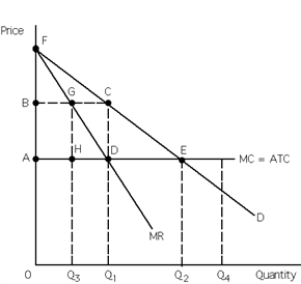 -Refer to Exhibit 23-10. The profit-maximizing single-price monopolist will produce which quantity of output?
-Refer to Exhibit 23-10. The profit-maximizing single-price monopolist will produce which quantity of output?
A) Q2
B) Q1
C) Q3
D) Q4
E) none of the above
Correct Answer

verified
B
Correct Answer
verified
Multiple Choice
Exhibit 23-9
 -Refer to Exhibit 23-9. A single-price monopolist earns a total profit of __________ when it produces the profit maximizing level of output.
-Refer to Exhibit 23-9. A single-price monopolist earns a total profit of __________ when it produces the profit maximizing level of output.
A) $120
B) $110
C) $180
D) $80
E) $49
Correct Answer

verified
Correct Answer
verified
Multiple Choice
Exhibit 23-6
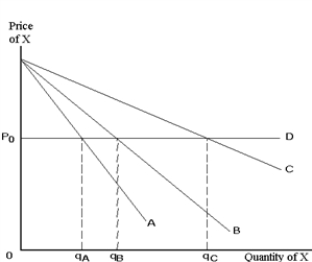 -Refer to Exhibit 23-6. If C is the demand curve facing a perfectly price-discriminating monopolist selling qC units of X, its marginal revenue curve is
-Refer to Exhibit 23-6. If C is the demand curve facing a perfectly price-discriminating monopolist selling qC units of X, its marginal revenue curve is
A) A.
B) B.
C) C.
D) D.
Correct Answer

verified
C
Correct Answer
verified
Multiple Choice
Suppose a monopolist practices perfect price discrimination. Its marginal revenue curve
A) will lie below its demand curve.
B) will lie above its demand curve.
C) will coincide with its demand curve.
D) has no definite relationship with its demand curve.
Correct Answer

verified
Correct Answer
verified
Multiple Choice
A monopolist can sell 8,000 units at a price of $10 per unit. Lowering price to all buyers by $1 raises the quantity demanded by 500 units. What is the change in total revenue resulting from this price change?
A) $3,500
B) -$12,500
C) -$3,500
D) -$18,000
E) There is not enough information provided to answer the question.
Correct Answer

verified
Correct Answer
verified
Multiple Choice
Exhibit 23-4
 -Refer to Exhibit 23-4. What dollar amounts go in blanks (T) , (U) and (V) , respectively?
-Refer to Exhibit 23-4. What dollar amounts go in blanks (T) , (U) and (V) , respectively?
A) $25; $30; and $40
B) $16; $19.50; and $23.60
C) $30; $40; and $29
D) $23; $15; and $28
Correct Answer

verified
Correct Answer
verified
Multiple Choice
Marginal revenue is equal to __________ divided by __________.
A) total revenue; the quantity of output
B) marginal cost; wages
C) the change in total revenue; the quantity of output
D) the change in total revenue; the change in quantity of output
E) the change in quantity of output; the change in total revenue
Correct Answer

verified
Correct Answer
verified
True/False
Economic rent is a payment received in excess of marginal cost.
Correct Answer

verified
Correct Answer
verified
Multiple Choice
Which of the following is characteristic of the monopoly firm?
A) It produces the quantity of output at which marginal revenue equals marginal cost, MR = MC.
B) It charges a price per unit for its product that is equal to marginal cost.
C) It always earns a profit, because it is a single seller of a product.
D) a and b
E) a and c
Correct Answer

verified
Correct Answer
verified
Multiple Choice
If economies of scale are so pronounced in an industry that only one firm can survive in the industry, this firm is called a(n) __________ monopoly.
A) financial
B) natural
C) structured
D) independent
Correct Answer

verified
B
Correct Answer
verified
Multiple Choice
Exhibit 23-2
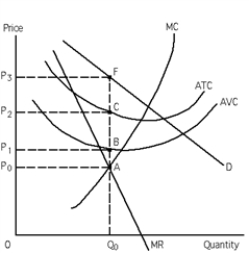 -Refer to Exhibit 23-2. The profit-maximizing monopolist produces Q0 units and charges a price of
-Refer to Exhibit 23-2. The profit-maximizing monopolist produces Q0 units and charges a price of
A) P0.
B) P1.
C) P3.
D) P2.
E) none of the above
Correct Answer

verified
Correct Answer
verified
Multiple Choice
Which of the following statements is true?
A) As a consequence of the monopoly firm producing the quantity of output at which price equals marginal cost, it is resource allocative efficient.
B) As a consequence of the perfectly competitive firm producing the quantity of output at which price equals marginal cost, it is resource allocative efficient.
C) a and b
D) none of the above
Correct Answer

verified
Correct Answer
verified
Multiple Choice
Exhibit 23-3
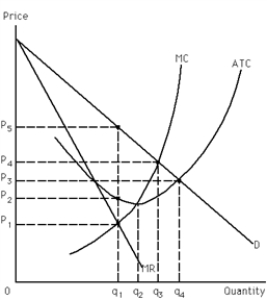 -Refer to Exhibit 23-3. The profit of the single-price monopolist is
-Refer to Exhibit 23-3. The profit of the single-price monopolist is
A) positive.
B) zero.
C) negative.
D) uncertain without more information.
Correct Answer

verified
Correct Answer
verified
True/False
Cents-off coupons can be seen as a form of third-degree price discrimination.
Correct Answer

verified
Correct Answer
verified
True/False
If a firm has no variable costs, the profit-maximizing price is also the revenue-maximizing price.
Correct Answer

verified
Correct Answer
verified
Multiple Choice
Exhibit 23-5
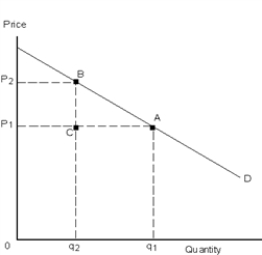 -Refer to Exhibit 23-5. What area represents the revenue gained when price goes from P2 to P1?
-Refer to Exhibit 23-5. What area represents the revenue gained when price goes from P2 to P1?
A) P1CBP2
B) q2CAq1
C) 0P1Aq1
D) CBA
Correct Answer

verified
Correct Answer
verified
Multiple Choice
The seller of good X sells 1,000 units of the good. Each unit is being sold for the highest price each consumer is willing to pay for the good. The seller practices
A) second-degree price discrimination.
B) third-degree price discrimination.
C) perfect price discrimination.
D) marginal revenue pricing.
E) rent seeking.
Correct Answer

verified
Correct Answer
verified
Multiple Choice
The theory of monopoly assumes that the monopoly firm
A) faces a downward-sloping supply curve that is the same as its marginal revenue curve.
B) faces a downward-sloping demand curve.
C) produces more than the perfectly competitive firm under identical demand and cost conditions.
D) produces a product for which there are many close substitutes.
E) none of the above
Correct Answer

verified
Correct Answer
verified
Multiple Choice
Which of the following is not an assumption of the theory of monopoly?
A) There is one seller.
B) The single seller sells a product for which there are many close substitutes.
C) There are extremely high barriers to entry.
D) b and c
E) a and c
Correct Answer

verified
Correct Answer
verified
Showing 1 - 20 of 195
Related Exams